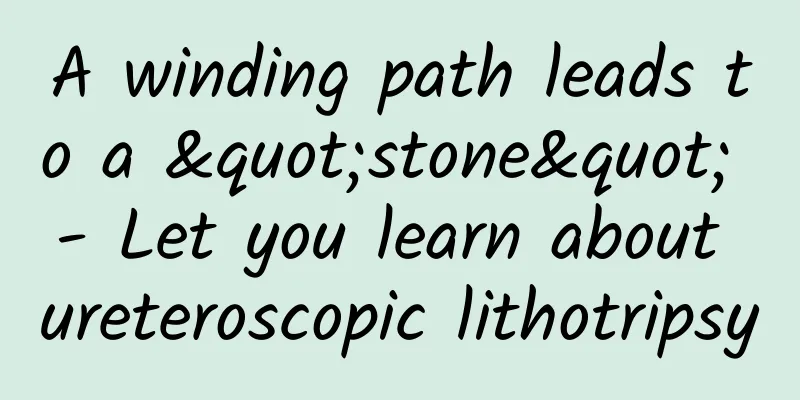A winding path leads to a "stone" - Let you learn about ureteroscopic lithotripsy

|
Author: Ye Zixing Peking Union Medical College Hospital Reviewer: Xiao He, Chief Physician, Peking Union Medical College Hospital Stones are a common disease of the urinary system. The pain caused by stone attacks is often unforgettable. The hydronephrosis caused by stones often damages the patient's renal function without knowing it. Therefore, it is very important to treat urinary stones in a timely manner. Figure 1 Copyright image, no permission to reprint There are many treatments for stones, and different methods are used for stones in different parts of the body. Both extracorporeal shock wave lithotripsy and ureteroscopic lithotripsy can be used to treat stones with a diameter of less than 2 cm in the kidney and ureter. You may have heard more about extracorporeal shock wave lithotripsy, but today we will introduce you to ureteroscopic lithotripsy. Figure 2 Copyright image, no permission to reprint Ureteroscopic lithotripsy is mainly suitable for the following situations: kidney and ureteral stones that are negative in X-ray examination; stone streets formed after extracorporeal shock wave lithotripsy; stones that have been impacted in the ureter for a long time; twisted and narrow ureter below the stone; bleeding tendency or inability to stop taking anticoagulants and antiplatelet drugs; hard stones that are not conducive to extracorporeal shock wave lithotripsy; stones in the renal calyx diverticulum; difficulty in establishing a percutaneous nephrolithotomy channel; extremely obese patients; kidney stones combined with parapelvic cysts; ectopic kidney combined with kidney stones; severe spinal deformity. Ureteroscopy is divided into two types: hard and soft. The hard ureteroscope is mainly used to treat stones in the middle and lower ureter, while the soft ureteroscope can "drill" into the upper ureter or even the kidney like a small snake, and move around in the kidney through the bend of the head to find stones hidden in the renal pelvis and calyx. During the lithotripsy process, the ureteroscope can reach the location of the stone along the ureter, and after the stone is crushed by energy equipment such as laser, the stone is removed with the stone removal and suction tools that match the ureteroscope. The remaining powdered stones can be gradually discharged with the patient's urine. After the operation, it is often necessary to leave a ureteral stent to facilitate the discharge of stones and prevent ureteral stenosis. Figure 3 Copyright image, no permission to reprint There may be certain risks in using ureteroscopic lithotripsy. Ureteral injury is the main surgical risk. Most ureteral injuries are mild and can be gradually healed by placing a ureteral stent. However, in rare severe cases, ureteral rupture may occur, which requires surgical treatment. In addition, urinary tract infection is a risk that needs to be fully taken seriously during and after ureteroscopic surgery. Advanced age, coexistence of underlying diseases such as diabetes, immunosuppressive state, hydronephrosis, etc. are risk factors for aggravation of perioperative urinary tract infection. Therefore, the risk factors for infection should be fully evaluated during the perioperative period, and infection prevention and empirical treatment should be carried out in a timely manner. In terms of the patient's recovery, most ureteroscopic surgeries have little impact on the whole body, and the patient can return to the preoperative state after fully waking up from anesthesia. Therefore, the patient can return to normal life on the first day after surgery or even on the day of surgery. In some hospitals, ureteroscopic lithotripsy has become a day surgery. However, since most patients still have ureteral stents in their bodies after surgery, patients may still experience hematuria, bladder irritation symptoms, and low back pain. However, as the body recovers and gradually adapts to the ureteral stent, the above discomfort will gradually subside, and generally has little impact on life. For patients with more obvious discomfort, α-receptor blockers (such as tamsulosin), M-receptor blockers (such as solifenacin), analgesics, etc. can be appropriately used to relieve symptoms. After the ureteral stent is removed, the physical discomfort will gradually subside, and no sequelae will be left. So how do we judge the effectiveness of ureteroscopic lithotripsy? Just like judging the effectiveness of other stone treatments, the effectiveness of stone removal can be further judged by reviewing kidney, ureter and bladder X-rays, as well as urinary system ultrasound or CT scans during postoperative follow-up. In conclusion, ureteroscopic lithotripsy is a safe and effective treatment for urinary tract stones. It has a definite surgical effect and patients recover quickly after surgery. It can be used to treat most kidney stones and ureteral stones. With the development of related surgical concepts, surgical instruments and surgical techniques, the stone clearance rate of ureteroscopic lithotripsy will gradually increase, the surgical risks will gradually decrease, and it will become the preferred treatment for more patients. |
<<: Bad emotions follow us everywhere. Where is the best way to treat them? - Meditation
>>: Lactation diet tips: scientifically match food to effectively promote lactation
Recommend
How to keep the brain of a 30-year-old at 60?
Review expert: Yin Tielun, deputy chief physician...
What causes bleeding in urine during pregnancy?
Some women are prone to bleeding in the urine in ...
15-year-old girl has acne on her face
Girls between the ages of 15 and 16 are most pron...
How to eat pistachios without getting angry? Why are pistachios green?
Pistachios are a nut rich in nutrients. Pure natu...
What are the signs that the uterus has recovered well after childbirth?
Then women need to pay attention to the recovery ...
There are three reasons for low flavonoids
For women, every hormone in the body is very impo...
How many days after the leucorrhea is stringy is it normal to ovulate?
For women, leucorrhea is very normal, but our bod...
Symptoms of Thalassemia in Women
If one of the parents suffers from thalassemia, t...
Is yellow leucorrhea caused by inflammation?
Women's health problems vary, and most women ...
Can I eat black rice during menstruation?
Although black rice is not a grain we eat frequen...
What to do about atypical breast hyperplasia? Introducing the correct approach
The specific treatment method for atypical breast...
Is hysteroscopy painful and how long does it take?
Women's body structure is more complicated, e...
How to jump rope to promote ovulation?
Nowadays, many women want to increase their ovula...
There is a lump in the breast that hurts when pressed. There is also a lump in the breast.
If there is a lump in the breast and it hurts whe...
Why do girls have back pain during their periods?
Generally speaking, girls have some symptoms duri...







![[Medical Q&A] What is the blood sugar control target for patients with type 2 diabetes?](/upload/images/67f0f24cbfd91.webp)

